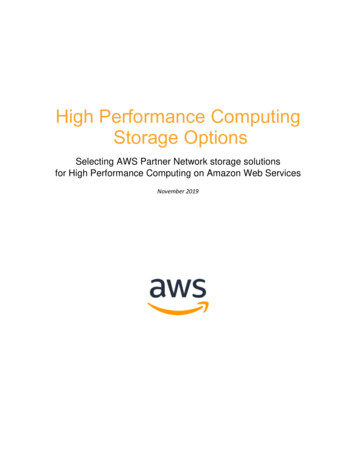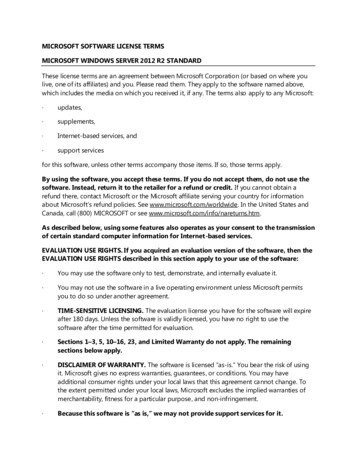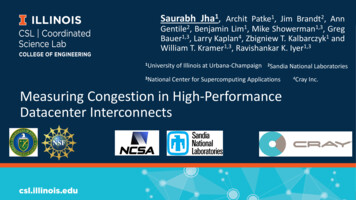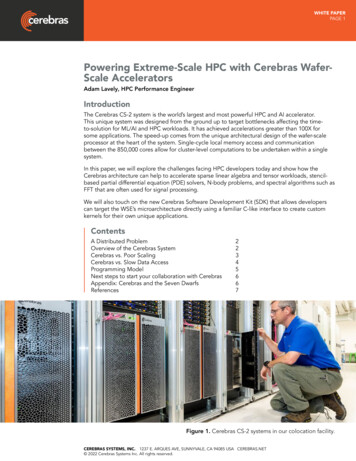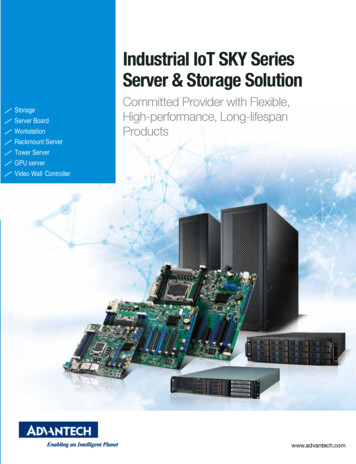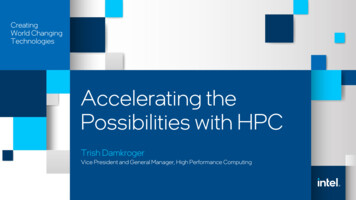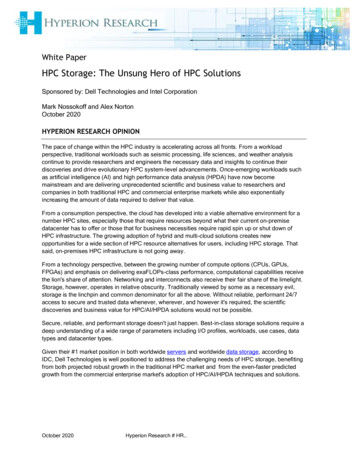
Transcription
White PaperHPC Storage: The Unsung Hero of HPC SolutionsSponsored by: Dell Technologies and Intel CorporationMark Nossokoff and Alex NortonOctober 2020HYPERION RESEARCH OPINIONThe pace of change within the HPC industry is accelerating across all fronts. From a workloadperspective, traditional workloads such as seismic processing, life sciences, and weather analysiscontinue to provide researchers and engineers the necessary data and insights to continue theirdiscoveries and drive evolutionary HPC system-level advancements. Once-emerging workloads suchas artificial intelligence (AI) and high performance data analysis (HPDA) have now becomemainstream and are delivering unprecedented scientific and business value to researchers andcompanies in both traditional HPC and commercial enterprise markets while also exponentiallyincreasing the amount of data required to deliver that value.From a consumption perspective, the cloud has developed into a viable alternative environment for anumber HPC sites, especially those that require resources beyond what their current on-premisedatacenter has to offer or those that for business necessities require rapid spin up or shut down ofHPC infrastructure. The growing adoption of hybrid and multi-cloud solutions creates newopportunities for a wide section of HPC resource alternatives for users, including HPC storage. Thatsaid, on-premises HPC infrastructure is not going away.From a technology perspective, between the growing number of compute options (CPUs, GPUs,FPGAs) and emphasis on delivering exaFLOPs-class performance, computational capabilities receivethe lion's share of attention. Networking and interconnects also receive their fair share of the limelight.Storage, however, operates in relative obscurity. Traditionally viewed by some as a necessary evil,storage is the linchpin and common denominator for all the above. Without reliable, performant 24/7access to secure and trusted data whenever, wherever, and however it's required, the scientificdiscoveries and business value for HPC/AI/HPDA solutions would not be possible.Secure, reliable, and performant storage doesn't just happen. Best-in-class storage solutions require adeep understanding of a wide range of parameters including I/O profiles, workloads, use cases, datatypes and datacenter types.Given their #1 market position in both worldwide servers and worldwide data storage, according toIDC, Dell Technologies is well positioned to address the challenging needs of HPC storage, benefitingfrom both projected robust growth in the traditional HPC market and from the even-faster predictedgrowth from the commercial enterprise market's adoption of HPC/AI/HPDA techniques and solutions.October 2020Hyperion Research # HR
SITUATION OVERVIEWThe HPC storage market is multi-faceted. Market dynamics influence budget and investmentprioritization areas. Traditional and emerging workloads drive new product requirements. Technologyevolution and integration provide the means with which HPC storage is incorporated into overall HPCarchitectures. Solution delivery, service and support enable new markets to take advantage of whatHPC has to offer. Each of these areas are examined in this paper.Market PerspectiveWhile the storage segment of the broader HPC market has traditionally been second in market sizebehind the HPC server market, it is the fastest growing HPC market segment. Table 1 summarizes thehistorical and forecast data for the broader HPC market segments.TABLE 1Revenues by the Broader HPC Market Areas ( Millions)201920202021202220232024CAGR 19-24Server 13,713 10,860 12,313 14,793 16,810 18,2625.9%Add-on Storage 5,427 4,375 5,010 6,097 7,098 7,7677.4%Middleware 1,614 1,286 1,459 1,778 2,034 2,2226.6%Applications 4,690 3,724 4,126 4,917 5,492 5,8604.6%Service 2,239 1,741 1,889 2,213 2,423 2,5352.5%Total Revenue 27,683 21,987 24,797 29,798 33,858 36,6465.8%Source: Hyperion Research, October 2020Examining the server and storage segments further in Table 2 reveals the increasing impact AI andHPDA workloads are contributing to the overall HPC storage market. 2020 Hyperion Research#HR4.0068.10.27.20202 Page
TABLE 2Post-COVID Worldwide HPC-Based AI Storage Revenues vs Total HPDA StorageRevenues ( Millions)201920202021202220232024CAGR'19-'24HPC Add-on Storage Revenues 5,427 4,375 5,010 6,097 7,098 7,7677.4%HPDA Add-on Storage Revenues 1,532 1,515 1,966 2,417 3,008 3,55118.3% 391 450 655 889 1,241 1,73034.7%HPC-Based AI Add-on StorageRevenues (ML, DL & Other)Source: Hyperion Research, 2020Although the scale and size of an HPC storage system varies between HPC competitive segments, thegeneral makeup and architecture of the storage solution is typically consistent. This widely useddesign approach allows for different configurations of the same basic system, typically architected asstorage building blocks, to be leveraged across the competitive server segments. While theSupercomputer segment accounts for the largest revenue, the Divisional and Departmental segmentsalso drive significant opportunities and should not be dismissed when architecting and designing HPCstorage solutions. Table 3 details the server and storage forecast for the HPC competitive segments.TABLE 3Worldwide Total Technical Computer Market Add-on Storage RevenueForecast by Competitive Segment ( lWorkgroupTotals201920202021202220232024CAGR 1924 2,318 1,902 2,389 2,789 3,420 3,84610.7% 751 616 695 880 967 1,0486.9% 1,660 1,310 1,369 1,774 2,022 2,1815.6% 698 547 557 654 690 691-0.2% 5,427 4,375 5,010 6,097 7,098 7,7677.4%Source: Hyperion Research, October 2020 2020 Hyperion Research#HR4.0068.10.27.20203 Page
HPC/AI/HPDA Workloads and Use CasesAI and HPDA workloads have been driving storage requirements beyond those of traditional HPCworkloads. Traditional HPC storage for conventional modeling and simulation typically consists ofproject, scratch, persistent and archive workloads. AI workflows present a different set of workloads:ingest, data preparation, training, inference, and archive. Some possess storage attributes like thoseof traditional HPC workloads and others drive new or more aggressive and extreme aspects.HPC and AI workloads often exhibit different I/O profiles. Traditional HPC workloads are typicallybased on large sequential I/O while AI workloads demand a mix of large sequential and small randomI/O. Metadata management for AI dataset tagging and labeling requires fast small random I/O.Use cases also drive a variety of durability and resiliency solution needs. Archiving requires extremelycost-effective solutions without demanding performance requirements. Traditional scratch applicationsrequire high performance with the ability to offload interim results to durable storage to protect againstfailures. AI and HPDA solutions require a mix of storage needs for both high performance, transientstorage and durable, resilient storage, including a balanced intermix of large block sequential andsmall block random I/O profiles.Lastly, data types drive requirements for different types of storage systems. Structured andunstructured data employ varying degrees of file, block and object access methods.Table 4 summarizes the relationship between workloads, use cases, I/O profiles and data types.TABLE 4Traditional HPC and AI/HPDA WorkloadsWorkloadUse CaseTraditionalHPCProjectDescription- Sometimes referred to as home directories or user files- Used to capture and share final results of the modelling and simulation- Mixture of bandwidth and throughput needs, utilizing hybrid flash and HDD storagesolutionsScratch- Workspace capacity used to perform the modelling and simulation- Includes metadata capacity (high throughput [IOs/sec] and flash-based) and raw datacapacity and checkpoint writes for protection against system component failure during longsimulation runs (high bandwidth [GB/s], traditionally HDD-based but now largely hybrid flashand HDDs)Archive- Long-term data retention- Scalable storage without a critical latency requirement- Largely near-line HDD-based systems with a growing cloud-based element- Typically file or object data typesAI & HPDAIngest- Quickly loading large amounts of data from a variety of different sources such that the datacan be tagged, normalized, stored and swiftly retrieved for subsequent analysis- Requires very high bandwidth (GB/s) performance at scale to sustain retrieving data rates,typically object-based from high-capacity HDD-based storage and increasingly cloud-based 2020 Hyperion Research#HR4.0068.10.27.20204 Page
TABLE 4Traditional HPC and AI/HPDA WorkloadsWorkloadUse CaseDataPreparationTrainingDescription- Often times referred to as data classification or data tagging, requires a balanced mix ofthroughput and bandwidth (hybrid flash and HDD storage systems)- Utilizing Machine Learning (ML) and/or Deep Learning (DL) to build an accurate model forresearchers, engineers and business analysts to use for their research, design andbusiness needs- Requires high throughput (IOs/sec) and low latency for continuous and repetitivecomputational analysis of the data, typically flash-based storageInference- Utilizing the model for experimentation and analysis to derive and deliver the targetedscientific or business insights- Also requires high bandwidth and low latency and typically flash-based, often with acaching layerArchive- Long-term data retention- Scalable storage without a critical latency requirement- Largely near-line HDD-based systems with a growing cloud-based element- Typically file or object data typesSource: Hyperion Research, October 2020Anatomy of an HPC Storage SystemHPC storage generally consists of the elements of an HPC system required to deliver a completeexternal add-on storage system. These elements include: Systems that house the controllers (RAID) and physical devices (HDDs, SSDs) thatrespectively provide the storage services (replication, snapshots, redundancy) and storagemedia that manage, store and maintain the data Expansion storage enclosures to provide additional storage media that scales out from astorage server File systems and servers dedicated to running the file system inclusive of primary storage,metadata storage and archive storage Storage interconnect switches and cabling that provide the connectivity between HPCcompute servers and storage servers, and between storage servers and enclosuresHPC storage systems had long been HDD-based. Flash-based tiers were introduced to support lowlatency needs driven by metadata as part of hybrid HDD/flash systems. Flash storage adoption hasbeen increasing in recent years to the point that all-flash storage systems are beginning to appear forHPC storage. Still, differing workloads drive different performance, scale and budget requirements andwill continue to drive demand for all HDD, hybrid HDD/flash and all flash HPC storage solutions.File systems bridge the gap between the applications consuming the data and the physical deviceswhere the data resides. They distribute the data being generated and analyzed by the HPCapplications running on the server across the storage media and manage its layout, performance and 2020 Hyperion Research#HR4.0068.10.27.20205 Page
resiliency. There are a variety of file systems that address varying degrees of scale, performance, dataservices, redundancy, resiliency, maintenance and support.The server-storage interconnect infrastructure is one of three HPC system interconnects (the othersbeing the compute-memory and server-server) within an HPC system. All three interconnects need tobe properly balanced to optimize the performance of the system. There are several server-storageinterconnects available, with the most broadly deployed being different generations and variations ofEthernet and InfiniBand.Complicating the discussion is the crossover occurring within elements of an overall HPC system. Onthe surface it's increasingly difficult to tell the difference between servers and storage. Productcategories such as storage servers and computational storage have emerged to address specificneeds such as object-based storage targets and edge computing devices, respectively.Beyond the HardwareThe line between enterprise and HPC market segments is blurring. Ease of management from theenterprise world is being leveraged into HPC storage systems, particularly in the area of metadatamanagement and proactive diagnostics and maintenance, while HPC-enabled AI is making its way intoenterprise systems, particularly in the areas of business intelligence and data analytics.Delivering the infrastructure that meets the demanding requirements of HPC users is necessary butnot sufficient for a vendor to be viewed as a major player in the HPC market. Historically, HPC vendorshave targeted datacenter managers and users possessing primarily technical and scientificbackgrounds: HPC datacenter and system managers: Technical aspects of the solution, e.g. performance (flops, IOPs, bandwidth), connectivity,capacity (PBs), core count, memory size, etc. Power consumption and cooling requirements Support and maintenance costsDomain-specific engineers and researchers Time to "science" in respective domain areas (e.g., bioscience, genomics, weather,climate, manufacturing, autonomic driving) Length of time to train an AI model Duration to achieve reliable AI inferencing resultsHPC techniques are now being leveraged in AI architectures, and commercial enterprise datacentersare adopting AI to deliver appropriate resources for their business's HPDA and business analytics. Toaddress this growing market, vendors' conversations today must evolve to target an increasinglybusiness-oriented audience, typically with fewer technical resources at their disposal to evaluate andimplement the complex infrastructure: Enterprise datacenter and system managers: Consumption model choices (outright purchase, lease, pay-as-you-go, cloud) Power consumption and cooling requirements Support and maintenance costs 2020 Hyperion Research#HR4.0068.10.27.20206 Page
Business unit managers: ROI analysis Domain-specific solutions Turnkey solutions targeted at specific domain areas Fully integrated, tested, certified and delivered solutionsProfessional services: Assistance for installation and tuning Options for continuing maintenanceThe need for turnkey solutions and professional services for installation, tuning and on-goingmaintenance and support in the traditional enterprise market cannot be overstated. When comparedwith the traditional HPC datacenter community, typical enterprise datacenters generally have fewerresources with the technical depth required for their increasingly complex AI infrastructures. Expertiseis required not only for the HPC hardware and software but also for the domain-specific knowledge(e.g., weather, bioscience, geoscience, autonomic driving) that can translate the respective domainrequirements into solutions that deliver breakthrough science and business results.One last item to consider is data locality. Data locality presents new and challenging datamanagement needs. Data is often generated from many different sources and needs to be sharedglobally. Depending on the type of data and the processing that needs to occur with it, it may remain atthe edge, be transferred to a central datacenter (either on-prem or in the cloud), or both.HPC STORAGE AND DELL TECHNOLOGIESA one-size-fits-all solution does not exist for HPC storage. There are myriad variables to considerwhen evaluating solutions and vendors for your HPC storage requirements: Workloads: Are you running traditional HPC Mod/Sim jobs? Is AI your primary focus? Whatabout HPDA? All the above? Use Cases: How is the data being used? Is there only one use case or will there be multipleuse cases? Consumption Model: Is your infrastructure on-prem? Are you running in the cloud? Both? System requirements: Do you need a full system, complete with servers, networking andstorage? Are you rolling your own system and looking only for the storage element? Breadth of solutions: Is a complete turnkey solution required, inclusive of integration testingwith domain-specific applications? Will you be requiring technical expertise to assist you inyour own testing and validation? Installation, service and support: Do you have the capabilities to perform your own installationservice and support? Are you looking for assistance from your system supplier? Do yourequire on-going professional services?As success in the enterprise datacenter market is as much about relationships as it is about theproducts and solutions themselves, and given the company's market leadership position in theenterprise datacenter for both servers and storage, Dell Technologies is well positioned to takeadvantage of the adoption of HPC and HPC-enabled AI techniques by enterprises. This is in additionto continuing to serve the needs of the traditional scientific HPC community. Augmented by theproduct, technology, service and support assets gained with the EMC acquisition several years ago, 2020 Hyperion Research#HR4.0068.10.27.20207 Page
Dell's broad HPC storage portfolio is a powerful combination of internally developed solutions andpartnered offerings. This portfolio covers the spectrum from individual storage elements to certifiedturnkey systems targeted for specific scientific and business domains, providing a wealth of options forusers. These include: The PowerEdge product line is a mainstay of the HPC storage portfolio. The recentlyannounced PowerEdge XE7100 storage server is a follow-on to the DSS7000. With 100 highcapacity, toolless drives and a one or two dual-socket compute node (with 2nd Gen IntelScalable Processors), and the ability to support file, block or object-based data, it is versatileenough to be used for either scratch or archive storage. The PowerEdge R740xd can beconfigured with up to 32 high-performance, low latency 2.5" SSDs, making it extremelysuitable for data-intensive AI/ML/DL workloads. Additionally, the R740xd is the basis for theData Accelerator, an open source, NVMe-based solution focused on supporting the broadHPC community to promote mitigation of I/O-related performance challenges. The PowerScale product line (derived from the former EMC Isilon product family), powered bythe latest release of its OneFS file system, addresses scalability by efficiently storing,managing, securing, protecting and analyzing unstructured file data. OneFS combines threelayers of traditional storage architectures — file system, volume manager and data protection —into a unified software layer, creating a single intelligent file system that spans all nodes withina cluster. OneFS also supports a wide range of data types and diverse workloads with built-inmulti-protocol capabilities including NFS, SMB, HDFS, S3, HTTP and FTP protocols, and canstore data anywhere – at the edge, in the datacenter or in the cloud. Dell EMC PowerVault product line of block-storage-based solutions is targeted as a generalpurpose building block with high-capacity and high-performance configurations suitable forproject, scratch, and persistent storage. Dell EMC ECS Enterprise Object Storage product line is a family of scalable storage solutionssuitable for both traditional HPC and data-intensive AI workloads. Built upon PowerEdgeservers, ECS is available as either a software-defined storage building block or as a turnkeyappliance to support cloud-based infrastructure and long-term data retention. Defined as Ready Solutions for HPC Storage consisting of a server, file system, networkingand storage, these solutions support multiple file systems (NFS, Lustre, BeeGFS, ArcaStream[GPFS]) to address a wide range of performance, scalability and data management needs,including project and persistent storage.TABLE 5Mapping Dell Technologies HPC Solutions to HPC WorkloadsWorkloadUse CaseProduct LinePowerEdgeTraditionalHPCProjectScratch 2020 Hyperion Research PowerScalePowerVaultECS #HR4.0068.10.27.20208 Page
TABLE 5Mapping Dell Technologies HPC Solutions to HPC WorkloadsWorkloadUse CaseProduct LinePowerEdgePowerVault ArchiveAI & HPDAPowerScale Ingest Data Preparation Training Inference Archive ECS Source: Hyperion Research, October 2020As products and solutions alone are not enough to address the needs of a complex HPC ecosystem,Dell Technologies offers several additional tools for customers to leverage: Dell Technologies on Demand: The cloud is increasingly being adopted as an HPC resourceincremental to on-premises infrastructure. Dell partners with leading CSPs to offer HPC cloudbased solutions to support customers with cloud-native, hybrid-cloud, and multi-cloudapplications. HPC & AI Innovation Lab: This team of engineers and subject matter experts collaborates withcustomers and partners to move beyond individual products and develop targeted solutionsHPC & AI workloads. The Lab is available directly to evaluate new technology or developfocused solutions for a specific outcome, or virtually via access on-line resources for bestpractices and benchmark results. Customer Solution Centers: Resourced with Dell personnel, these centers provide customerand partners free hands-on access to Dell infrastructure and the opportunity to interact directlywith Dell for demos and testing before buying. Interaction with the HPC & AI Innovation Lab foradvanced solution engineering and performance testing is also available through thesecenters. HPC & AI Centers of Excellence: With almost a dozen locations around the world, these thirdparty centers develop and maintain local partnerships, test new technologies, share bestpractices and function as entry-points for customers to provide feedback and influence futureproduct roadmaps. Dell HPC Community: Pre-COVID-19, Dell facilitated several in-person gatherings throughoutthe year for worldwide community networking and collaboration. Successfully evolving this toan on-line virtual activity, the Dell HPC Community event is a vibrant weekly gathering led by a 2020 Hyperion Research#HR4.0068.10.27.20209 Page
combination of industry subject matter experts and Dell HPC experts to provide insight andeducation across a wide variety of HPC topics, including HPC storage.Leveraging the tools above as a whole, coupled with extending the highly regarded, world classservice and support organization obtained from EMC, will be instrumental for Dell to successfullyaccelerate the enterprise datacenter's adoption and integration of HPC solutions to address AIworkloads and ultimately deliver the resulting business value for their customers.FUTURE OUTLOOKHPC storage is a critical element of leading HPC system architectures. Understanding and balancingperformance, availability, resiliency, capacity and budgetary requirements will continue to determinethe overall technical and business success of an HPC storage system.Adding to the challenge and complexity of delivering HPC storage solutions is the emergence of AIinnovations being adopted by both traditional HPC and commercial enterprise datacenters. As moreenterprises realize the value and benefits of HPC-enabled AI techniques, vendors will find anincreased TAM (Total Available Market) for their HPC solutions. Enterprise users will rely on vendorsto not only provide the physical products and solutions but also HPC and scientific/business domainexpertise to allow them to fully exploit the capabilities of HPC-enabled AI technology.As the global server and storage leader in the traditional enterprise market and the fastest growingHPC server vendor, Dell Technologies is well positioned to serve the HPC storage community. Dell'sarray of HPC storage-related tools (broad product portfolio, growing suite of tested and certifiedsolutions, HPC and scientific domain expertise, cloud offerings, service and support) meritconsideration from users who are deciding on their HPC solutions partner in general, and HPC storagepartner in particular. 2020 Hyperion Research#HR4.0068.10.27.202010 P a g e
About Hyperion Research, LLCHyperion Research provides data-driven research, analysis and recommendations for technologies,applications, and markets in high performance computing and emerging technology areas to helporganizations worldwide make effective decisions and seize growth opportunities. Research includesmarket sizing and forecasting, share tracking, segmentation, technology and related trend analysis,and both user & vendor analysis for multi-user technical server technology used for HPC and HPDA(high performance data analysis). We provide thought leadership and practical guidance for users,vendors and other members of the HPC community by focusing on key market and technology trendsacross government, industry, commerce, and academia.Headquarters365 Summit AvenueSt. Paul, MN 55102USA612.812.5798www.HyperionResearch.com and www.hpcuserforum.comCopyright NoticeCopyright 2020 Hyperion Research LLC. Reproduction is forbidden unless authorized. All rights reserved. Visitwww.HyperionResearch.com to learn more. Please contact 612.812.5798 and/or email info@hyperionres.com forinformation on reprints, additional copies, web rights, or quoting permission. 2020 Hyperion Research#HR4.0068.10.27.202011 P a g e
2020 Hyperion Research #HR4.0068.10.27.2020 6 P a g e resiliency. There are a variety of file systems that address varying degrees of scale, performance, data services, redundancy, resiliency, maintenance and support. The server-storage interconnect infrastructure is one of three HPC system interconnects (the others


